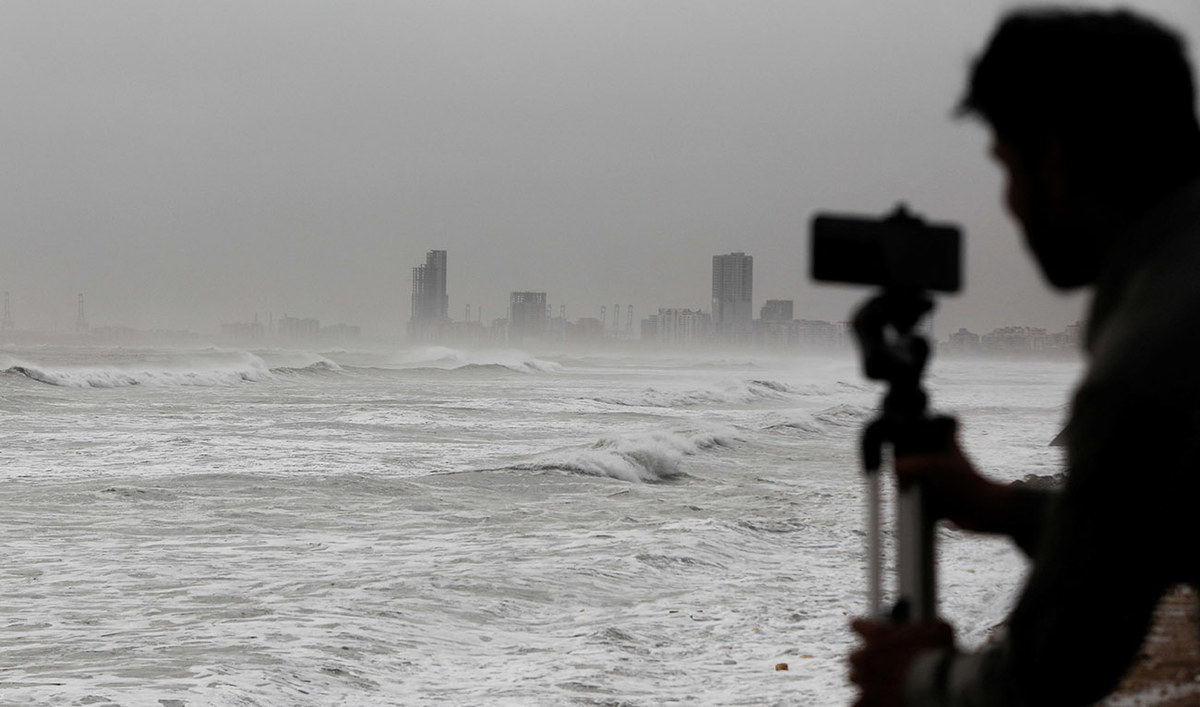KARACHI: Pakistani’s disaster management authorities have said that around 100,000 people will be evacuated to safer areas as a powerful cyclonic storm, Biparjoy, continue to drift toward the country’s southern coast on Tuesday, changing its direction from India in the last 12 hours.
Cyclone Biparjoy began as a deep depression over the Arabian Sea last week, but later intensified into a very severe cyclonic storm, according to the Pakistan Meteorological Department (PMD). The storm moved further north-northwestward in the last 12 hours and was now at a distance of about 470km from Karachi.
As the storm is expected to cross between Keti Bandar in Pakistan’s southern Sindh province and the Indian state of Gujarat on June 15, the government in Pakistan’s southern Sindh province has already kicked off an evacuation drive in coastal villages and islands.
On Tuesday, Lt Gen Inam Haider Malik, chief of Pakistan’s National Disastaer Management Authority (NDMA), said up to 100,000 citizens needed to be evacuated to safer locations by Wednesday.
“According to the data we have shared with the military formations [performing rescue operations in vulnerable areas], there are close to 100,000 people who have to be evacuated from there,” Malik said at a press conference alongside the country’s climate change minister.
“This process will be rapidly completed either tomorrow evening or early morning on Thursday.”
Due to the melting of the glaciers, the NDMA chief said, it was predicted that such a cyclone could occur in the Arabian Sea in the monsoon season. An emergency had been imposed in Sindh and all institutions were on standby to deal with any emergency situation, he added.
Climate Change Minister Sherry Rehman said the government was taking all measures to keep the citizens safe.
“The government has started taking all the measures to keep the citizens safe by evacuating them, especially those living in the coastal areas of Keti Bandar, Thatta, and Badin where heavy rains are expected between June 14 — 16,” Rehman said.
“We had to forcefully evacuate some people because citizens’ safety is our priority.”

Before the arrival of cyclonic storm, Biparjoy, over the Arabian Sea, at Clifton Beach in Karachi. (Reuters)
She said all rescue missions and agencies had been put on alert and the provincial authorities in Sindh were closely working with the NDMA in dealing with the situation.
Earlier in the day, Rehman warned the citizens of Karachi that the port city would likely experience urban flooding following heavy rains given the scale and intensity of winds.
“Precautionary evacuations in Seaview areas have begun,” Rehman wrote on Twitter.
“So far, it has reduced intensity only for the Balochistan side am told but it is highly unpredictable so please do NOT take it casually. It is varying in intensity but caution is crucial, esp near the Sindh coast.”
On Tuesday, the Met Office said Biparjoy had moved further north-northwestward and was now at a distance of about 470km south of Karachi and 460km south of Thatta.
“Under the existing upper-level steering winds, the VSCS “BIPARJOY” is most likely to track further Northward until 14 June morning, then recurve Northeastward and cross between Keti Bandar (Southeast Sindh) and Indian Gujarat coast on 15 June afternoon/evening as a Very Severe Cyclonic Storm (VSCS) with packing winds of 100-120Km/hour,” the Met depart said.
Possible impacts included the cyclone’s probable approach to the southeast Sindh coast, widespread wind, dust and thunderstorms, and heavy rain accompanied by “squally winds of 80-100Km/hour gusting 120km/hour likely in Thatta, Sujawal, Badin, Tharparker, Mirpurkhas & Umerkot districts during 13-17 June.”
Storms and rain are also expected in Karachi, Hyderabad, Tando Muhammad Khan, Tando Allayar, Shaheed Benazirabad, and Sanghar districts from June 14-16.
“Squally (high intensity) winds may cause damage to loose & vulnerable structures (Kutcha houses) including solar panels etc,” the Met statement said. “Storm surge of 3-3.5 meters (8-12 feet) expected at the land falling point (Keti Bandar and around) which can inundate the low-lying settlements.”
The Met department also warned fishermen not to venture in open seas till the system was over by June 17.


















